78 Search Results for object symbols
September 16, 2015
by Carole Zangari -
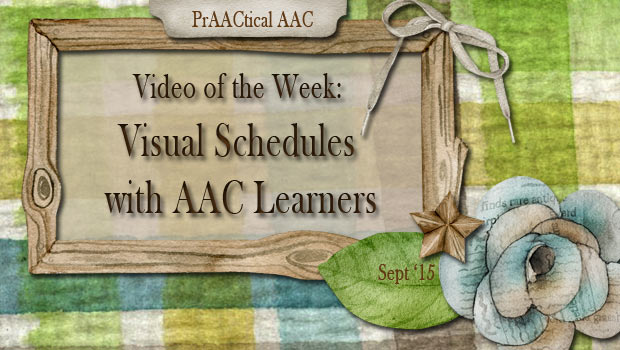
While our therapy sessions are highly individualized to meet the needs of specific individuals, there are a couple of strategies that are effective with almost every learner on our caseloads. Topping that list is the use of visual schedules. Whether it is a written agenda, a picture schedule for the session, a mini schedule for the parts of an activity, or an object schedule for the day’s events, this is one of the few strategies that has something to offer every learner. We’ve written before about this topic. In this post, you can find links to many of the topics we’ve addressed about making and using them. Today, we’ll look at a few videos on the use of this strategy. To get us started, here’s a video of Ann Syrstad sharing information about using this evidence-based intervention for individuals with ASD. Next, we head to Malaysia, where the Early Autism... [Read More...]
August 12, 2014
by Carole Zangari -
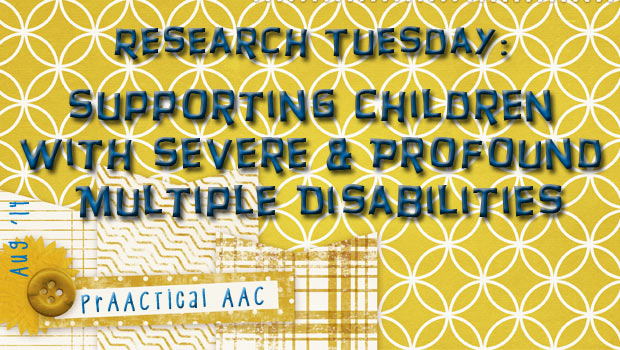
What do we know about the best ways to provide communication support to individuals with severe and profound multiple disabilities (PMLD)? PMLD is a term that generally refers to people who experience profound cognitive limitations in addition to sensory and/or physical disabilities. Many of these individuals have complex medical histories and chronic health concerns. Often, the communication difficulties experienced by individuals with PMLD cause them to be isolated and excluded from many social and educational opportunities. Despite their many challenges, there is evidence to suggest that AAC supports can help these children develop their communication skills. Not much is known, however, about how to structure the AAC intervention to maximize learning. In this study, Harding and her colleagues sought to reduce isolation and promote personal autonomy by providing AAC supports to two children with PMLD. As other researchers have demonstrated the positive impact of AAC on people with PMLD, this... [Read More...]
July 8, 2014
by Carole Zangari -
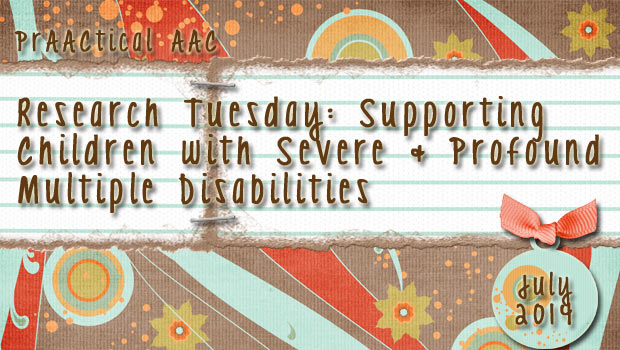
What do we know about the best ways to provide communication support to individuals with severe and profound multiple disabilities (PMLD)? PMLD is a term that generally refers to people who experience profound cognitive limitations in addition to sensory and/or physical disabilities. Many of these individuals have complex medical histories and chronic health concerns. Often, the communication difficulties experienced by individuals with PMLD cause them to be isolated and excluded from many social and educational opportunities. Despite their many challenges, there is evidence to suggest that AAC supports can help these children develop their communication skills. Not much is known, however, about how to structure the AAC intervention to maximize learning. In this study, Harding and her colleagues sought to reduce isolation and promote personal autonomy by providing AAC supports to two children with PMLD. As other researchers have demonstrated the positive impact of AAC on people with PMLD,... [Read More...]
August 22, 2012
by Carole Zangari -
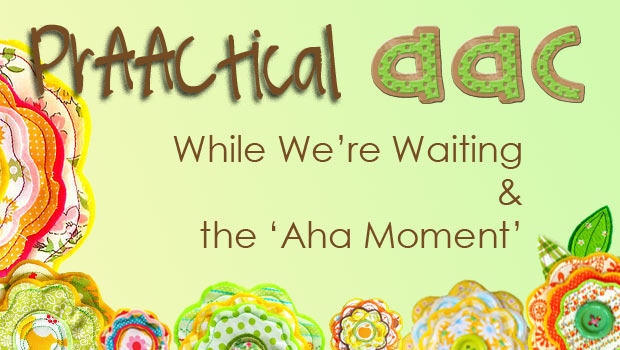
We tried to be patient. We really did. We tried to wait until we had the new venue for our site all figured out and ready to go, but the truth is, we missed blogging and hated the thought of going a few more weeks without being able to post. So we decided to reactivate our old site for the time being and post occasionally to this site. Pardon our dorky look, please. In case you missed these on Facebook, here are are a couple of things we shared in the past few weeks: Lemonade: http://screencast.com/t/xaFcbxySW Building Classroom Participation: http://www.screencast.com/users/CZee/folders/Jing/media/15818f72-c49f-4da6-a12d-e52250794234 PrAACtical Alert: Online Trainings: http://bit.ly/NZ9HYT COCOA: http://www.edutecher.net/educlipper/index.php?shareImgid=2478 AAC Rating Scales: http://www.edutecher.net/educlipper/index.php?shareImgid=2499 and http://bit.ly/Ocgte5 And now onto something new… Last week, I had the chance to talk with Karyn, a mom whose adorable daughter with significant vision impairment and multiple disabilities is entering school for the first time. As she helped... [Read More...]
March 10, 2012
by Carole Zangari -
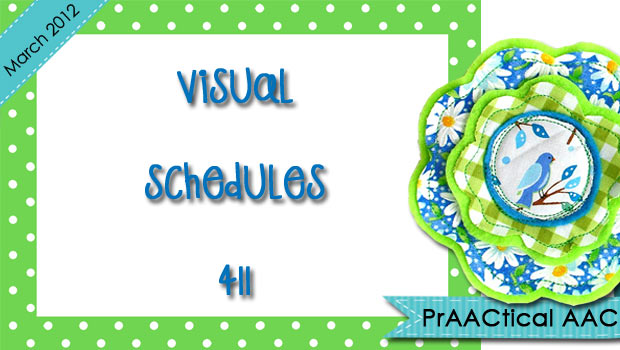
Visual schedules come in all shapes and sizes. The process of deciding which one to use begins with two questions: What is the purpose of this particular visual schedule? How will it be used? Both of these drive the decisions you make about which format to use. If my primary purpose in making the visual schedule is to help a student become more independent in following the steps in a task, and I know the person is going to be seated at a desk while doing this, I may choose a horizontal layout that shows the sequence. Because it is a school-aged child and we are activity working on literacy skills, I consider a stationary format on the desk surface that has the student use a check-off system. Having the student cross out or check off the steps as they are completed, gives authentic practice with writing skills. On the... [Read More...]
March 3, 2012
by Carole Zangari -
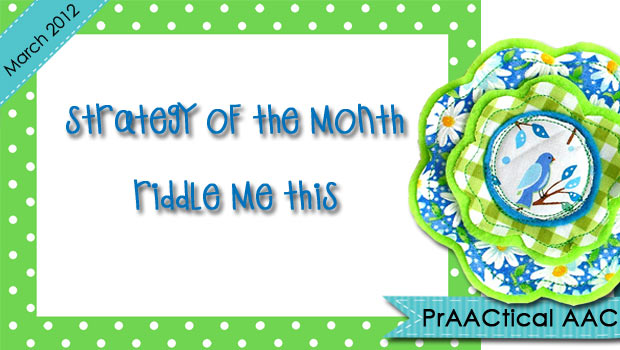
Here’s a riddle for you. Read the clues and guess what tool or strategy we’re talking about. Clue #1: It’s used in almost every classroom and therapy room serving students with ASD. Clue #2: The one for Johnny looks almost the same as the one for Jenny. Clue #3: It looks as nice in June as it did in September. If you guessed visual schedules, you’ve just named our March Strategy of the Month. Visual Schedules? But everybody already uses those. Why post about those? — Here’s why. – They’re ubiquitous. And yet when we talk with educators and SLPs about how the children are doing with their schedules, we get a look and a shrug. “Okay, I guess.” To be sure, okay is better than not okay. But visual schedules have so much potential to make lives better for clinicians, educators, and people with AAC needs that okay isn’t... [Read More...]
January 23, 2012
by Robin Parker -

AAC & The Art of the Unconventional Conversation, Carole’s post from Saturday, recounts a young girl who some people might have thought was not ready for AAC. It reminds me a young man I know, Michael. I met Michael when he was 14, after he was discharged from all of his communication intervention or I should say his speech-language therapy sessions. He was discharged at school because when he moved from his autism classroom in middle school to a high school classroom for children with varying exceptionalities, it was ‘felt’ that he did not need it anymore. He had not made ‘progress’ in his speech and language goals, he did not talk, he did not consistently identify objects, and he did not essentially do a lot of things. He was discharged from his private therapy as he was not making progress in a lot of goals there either. Everyone... [Read More...]
January 20, 2012
by Carole Zangari -
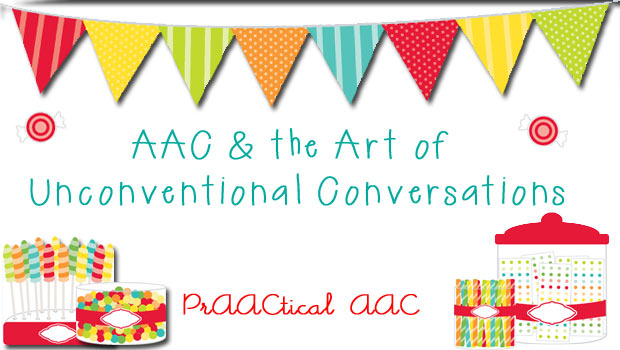
There’s an art to having a conversation with someone who has significant communication challenges. One of my favorite experiences with this dates back to the 1980’s, when I was working with a preschooler who had Rett Syndrome. Julia was a beautiful little girl who lived with her (very young) mom and her grandma. Grandma watched Julia while mom was in school, and I spent a good amount of time visiting them in their modest home (a trailer) trying to earn their trust and figure out how to help Julia communicate better in school. – At home, as it turns out, she was communicating just fine, at least for the very basic things. A typical conversation between Julia and her grandma went like this. Julia paces around the coffee table, wringing her hands, rocking a bit, and staring at the carpet. She pauses in front of the TV and Grandma says... [Read More...]
September 16, 2023
by Carole Zangari -
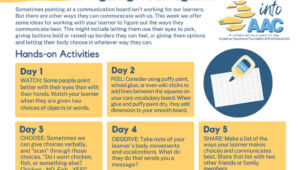
About This Week Welcome to Week 8 of your Stepping into AAC journey! We wrap up our detour on personalizing communication boards by taking a close look at ways to support AAC learners who have difficulty pointing to words and picture symbols. You will explore the following concepts this week: Alternative Access: Learn about options for AAC learners with motor challenges. Learning Through Engagement: Explore ways that we can engage AAC learners in experiences that allow them to advance their language and communication skills. AACtion Steps Week 8 AACtion Steps Signposts Get the Handout Overview of Alternative Access Travelog Week 8 Travelog Print the Week Want all of the resources shared in this week’s Stepping into AAC? You can download the entire digital bundle by clicking the download button below.
September 16, 2023
by Carole Zangari -
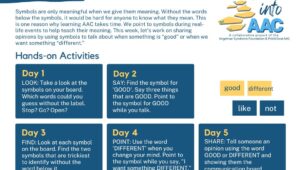
About This Week Welcome to Week 3 of your Stepping into AAC journey! This week will get us thinking about how words are symbolized, what kinds of words should be on AAC systems, and other foundational information. We will explore the following concepts this week: Why Use Symbols for AAC? Gain an understanding of symbolic communication and issues related to using picture symbols in AAC systems. Balancing Core and Fringe Vocabulary: Learn about different types of words that AAC learners need access to and the role of each. Navigating AAC: Build your knowledge of the logic in the design of communication boards, AAC apps, and speech-generating devices. AACtion Steps Week 3 AACtion Steps Signposts Link to References Gayl Porter & Linda Burkhart, 2010 – Limitations of Using a Representational Hierarchy Get the Handout Balancing Core & Fringe Get the Handout Navigating AAC- 3 Things to Know Travelog Week 3 Travelog... [Read More...]









